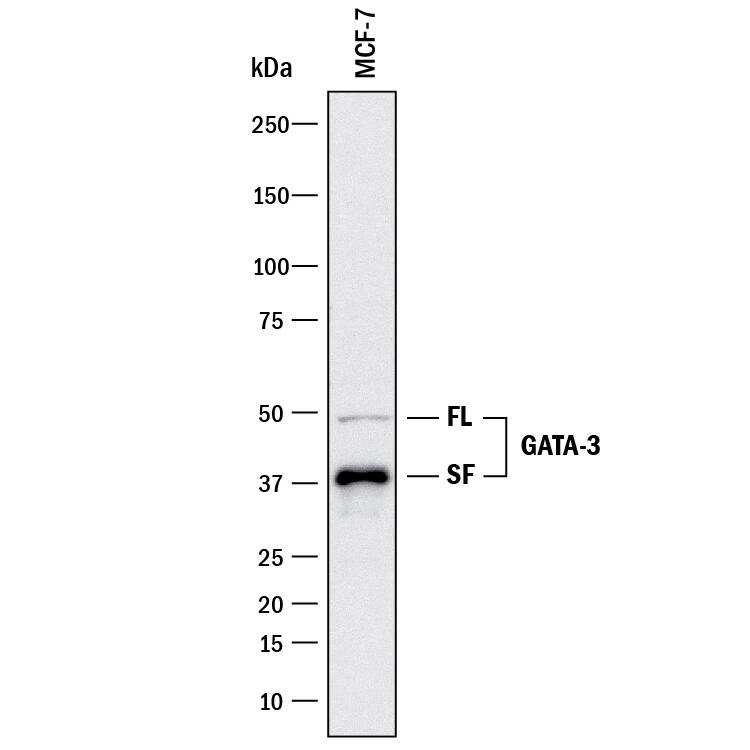Human GATA-3 Antibody
R&D Systems, part of Bio-Techne | Catalog # MAB26051


Key Product Details
Species Reactivity
Validated:
Cited:
Applications
Validated:
Cited:
Label
Antibody Source
Product Specifications
Immunogen
Pro135-Ser258
Accession # P23771
Specificity
Clonality
Host
Isotype
Scientific Data Images for Human GATA-3 Antibody
Detection of Human GATA‑3 by Western Blot.
Western blot shows lysates of MCF-7 human breast cancer cell line. PVDF membrane was probed with 2 µg/mL of Mouse Anti-Human GATA-3 Monoclonal Antibody (Catalog # MAB26051) followed by HRP-conjugated Anti-Mouse IgG Secondary Antibody (Catalog # HAF018). Specific bands were detected for GATA-3 full length (FL) at approximately 50 kDa and the splice form (SF) at approximately 37 kDa (as indicated). This experiment was conducted under reducing conditions and using Immunoblot Buffer Group 3.GATA-3 in MCF-7 Human Cell Line.
GATA-3 was detected in immersion fixed MCF-7 human breast cancer cell line using 10 µg/mL Human GATA-3 Monoclonal Antibody (Catalog # MAB26051) for 3 hours at room temperature. Cells were stained with the NorthernLights™ 557-conjugated Anti-Mouse IgG Secondary Antibody (red, upper panel; Catalog # NL007) and counterstained with DAPI (blue, lower panel). View our protocol for Fluorescent ICC Staining of Cells on Coverslips.Applications for Human GATA-3 Antibody
Immunocytochemistry
Sample: Immersion fixed MCF-7 human breast cancer cell line
Western Blot
Sample: MCF‑7 human breast cancer cell line
Formulation, Preparation, and Storage
Purification
Reconstitution
Formulation
Shipping
Stability & Storage
- 12 months from date of receipt, -20 to -70 °C as supplied.
- 1 month, 2 to 8 °C under sterile conditions after reconstitution.
- 6 months, -20 to -70 °C under sterile conditions after reconstitution.
Background: GATA-3
GATA-3 belongs to the GATA family of transcription factors, which bind to the consensus DNA sequence (A/T) GATA (A/G) to control diverse tissue-specific programs of gene expression and morphogenesis. It is widely expressed in mesodermal- and endodermal-derived tissues. GATA-3 has been shown to be an essential regulator for immune cell function, sympathetic neuron development, and the maintenance of the differentiated state in epithelial cells.
Additional GATA-3 Products
Product Documents for Human GATA-3 Antibody
Product Specific Notices for Human GATA-3 Antibody
For research use only
